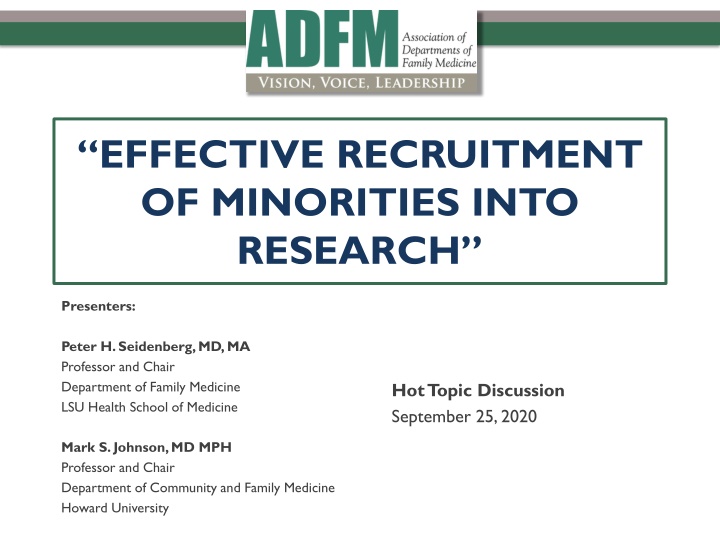
Effective Recruitment of Minorities into Research for Improved Representation and Validity
Learn about the importance of recruiting minorities into research, reasons for their underrepresentation, protections in place for research subjects, and key strategies for successful recruitment planning. Discover the essential role of minority recruitment in enhancing internal and external validity, addressing healthcare disparities, and meeting funding requirements. Explore historical instances of distrust in research and current safeguards established to protect human subjects. Gain insights on early planning steps, target setting, and community engagement to ensure diverse representation in research studies.
Download Presentation

Please find below an Image/Link to download the presentation.
The content on the website is provided AS IS for your information and personal use only. It may not be sold, licensed, or shared on other websites without obtaining consent from the author. If you encounter any issues during the download, it is possible that the publisher has removed the file from their server.
You are allowed to download the files provided on this website for personal or commercial use, subject to the condition that they are used lawfully. All files are the property of their respective owners.
The content on the website is provided AS IS for your information and personal use only. It may not be sold, licensed, or shared on other websites without obtaining consent from the author.
E N D
Presentation Transcript
EFFECTIVE RECRUITMENT OF MINORITIES INTO RESEARCH Presenters: Peter H. Seidenberg, MD, MA Professor and Chair Department of Family Medicine LSU Health School of Medicine Hot Topic Discussion September 25, 2020 Mark S. Johnson, MD MPH Professor and Chair Department of Community and Family Medicine Howard University
WHY IS RECRUITMENT OF MINORITIES IMPORTANT? Internal vs. External Validity Funding sources often require minority representation Healthcare disparities
WHY ARE MINORITIES UNDERREPRESENTED IN STUDY POPULATIONS? Distrust of research Tuskegee Syphilis Study 1932-1972 399 men Studies on prisoners Guatemala - STIs Joilet, IL - Malaria Philadelphia, PA viral hepatitis Columbus, OH cancer cells National Archives Role of healthcare disparities??
PROTECTIONS IN PLACE FOR RESEARCH SUBJECTS 1947 - Nuremberg Code 1964 - Declaration of Helinski 1966 - Office for Protection of Research Subjects (NIH) IRBs 1974 - National Research Act National Commission for the Protection of Human Subjects 1979 HHS Ethical Principles and Guidelines for the Protection of Human Subjects of Research
SUCCESSFUL RECRUITMENT BEGINS WITH PLANNING
THERE IS NO RESEARCH WITHOUT SUBJECTS
NIH REQUIRES MINORITY RECRUITMENT. IF NOT, JUSTIFICATION IS REQUIRED
EARLYPLANNING Have a target Target should be considered for sample size Literature review should include epidemiologic reasons why outcomes might be different in women or minorities Have members of the target groups involved with the research team early Community members and organizations clinicians
BUDGET CONSIDERATIONS Do not underbudget recruitment (if you build it they might not come) Do prescreening to determine how many people need to be contacted to yield one research subject Consider that the dropout rate may be higher with low income persons Consider barriers to participation that affect low income persons Child care Inability to take off from work Transportation Parking
HAVE A COMMUNICATION PLAN How will you reach out? What is the target reading level of written material? To what extent will the media be used? Provide diverse pictures in all media Give ongoing reports to all targeted constituencies
IF THERE ARE NOT A LOT OF MINORITIES IN YOUR COMMUNITY CONSIDER A MULTISITE PLAN






















